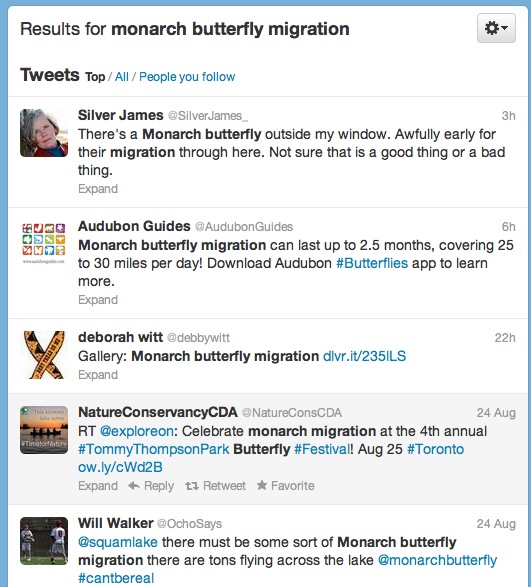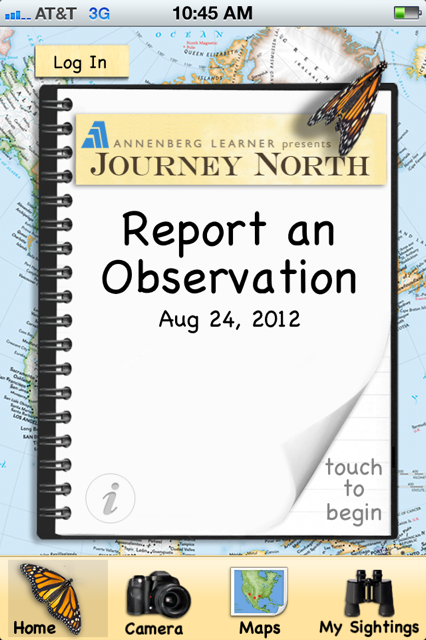The Monarch butterfly migration is underway. Early reports from Canada suggest they’re embarking on directional southward flight, the first sign that migratory behaviour is afoot. Next, they’ll start roosting. Meanwhile, Monarch watchers in the northern reaches are reporting FOS (first of season) sightings.

Coming soon to nectar sources near you: Monarch butterflies
We generally see Monarch butterflies at our Llano River ranch during Labor Day weekend, but I saw my FOS in Austin last week. Another graced my San Antonio front yard garden on Tuesday. Given our hepped up weather pattern, an early migration seems likely.
In his periodic state-of the-union message assessing this year’s Monarch butterfly population August 20, Dr. Chip Taylor of Monarch Watch suggested the migratory population will be small this year, occupying only three hectares once they arrive in Mexico. Taylor cited a “year like no other” in the 117 years that climate records have been kept, with crazy weather and drought resulting in a late season lack of nectar and host plant sources. As we wrote last week, wildfires in Oklahoma and aerial spraying of insecticides in a battle against West Nile virus in North Texas and now elsewhere could further complicate Monarch’s migratory journey.
That makes tracking Monarchs this year even more interesting than usual. The good news is more resources for following their progress exist than ever. I’ve listed my favorites below.
Twitter Search
Using Twitter as a search engine is my favorite Monarch butterfly tracking tool. It provides real-time updates of Monarch butterfly sightings. Granted, not everyone uses Twitter, but for those who do and are interested in clocking the migration in real-time, it can be indispensible.
Twitter is a free, real-time search engine, as well as a broadcast outlet for individuals and organizations. That means you can visit http://search.twitter.com and punch in “monarch butterflies” or “monarch migration” or “monarch butterfly” and dozens of hours-old “tweets”–brief 140-character updates—will be returned, telling you where Monarchs are flying RIGHT NOW.
Twitter was conceived as a mass text messaging tool, thus the brevity of the updates. It refreshes constantly. And to use Twitter as a search engine, you don’t even need to open an account.
Twitter search ONLY indexes recent updates. Google and other search engines are more akin to archives for the entire web. You can try searching Google News, but this won’t return the on-the-ground reports Twitter delivers. Like these, from today:

The results from these searches paint a real-time picture of what’s happening with the Monarch migration NOW. Yes, there’s junk in there, but also insights, relevant news stories, photos and facts. By clicking on the Twitterer’s profile, you learn their location.
Don’t scoff. Give it a try and check out this Twitter search for the Monarch butterfly migration.
Monarch Watch Facebook Page
If you’re reading this blog and you’re on Facebook, then you likely have already “LIKED” the Monarch Watch Facebook page. If not, go ahead, do it now, and join the party. (And while you’re at it, why not LIKE the Texas Butterfly Ranch Facebook page?)
With more than 8,700 fans, Monarch Watch’s page serves as a delightful online plaza where the Monarch Watch team from the University of Kansas engages with the rest of us to share information, photos, and wax passionate about Monarch butterflies and their migration. Citizen scientists, recreational observers, and professional and amateur biologists and entomologists join the conversation. Like this:

I almost always learn something from the Monarch Watch Facebook page. Here, veteran caterpillar wranglers offer wisdom born from hundreds of hatched chrysalises, newbie enthusiasts pose curious questions and the sharp folks at Monarch Watch and the crowd set inaccuracies straight. The photos are often amazing, like the one above of Monarchs “doing it.”
Journey North
Billed as the nation’s premiere citizen scientist project for children, Journey North tracks wildlife migrations and seasonal change. This time of year, they post a weekly migration update on Thursdays based on observations from Monarch butterfly enthusiasts of all ages, from Canada to Mexico. Here’s an excerpt from a recent report:
First Signs in North Observers in Canada reported directional flight for the first time this week, a clear sign of migration:
“Monarchs flying in a southwest direction at the Kenesserie Tallgrass Prairie. Monarchs have been very common at this prairie site all summer, but now they are flying in the same direction rather stopping to browse for milkweed or nectar.” 8/19/12 Highgate, Ontario
Watching the Map We’re expecting the first report of roosting monarchs any moment. The shift to roosting behavior is another sign of fall migration, and is typically first reported from northern latitudes by now.
The Journey North website is specifically written for children and educators, and its teacher tone can be grating to those further down the road in their Monarch educations. That said, the site offers loads of useful tools and resources for teachers and others on the Monarch butterfly migration.
Journey North recently launched a laudible app that allows citizen scientists to post sightings of migratory species from their phones. Check out the app and sign up if it suits you.
Monarch Watch Website
Journey North devotes itself to wildlife migrations besides Monarch butterflies (they also monitor hummingbirds, whales and birds), but the Monarch Watch website brags Monarch butterflies, all the time.

Based at the University of Kansas at Lawrence, Monarch Watch founded the citizen scientist tagging program embraced by thousands of us who tag Monarchs each fall. Its comprehensive website offers information on how to tag a Monarch, raising milkweed, rearing Monarch caterpillars, and a database of all the Monarch tags recovered in Mexico, so those of us who tag can find out if any of our butterflies made it home.
The site also posts predictions for when the peak migration will occur at your latitude based on Monarch Watch scientists’ well-researched opinions. The Monarch Watch blog is also worth a look.
D-Plex List
If the above won’t sate your migration curiosity, then consider signing up for the D-PLEX list, an email exchange that includes about 650 scientists, conservationists, enthusiasts, and others, including some very interesting characters.
Named after the Monarch butterfly’s Latin designation, Danaus plexipus, the D-PLEX is an old fashioned email listserv started by Dr. Taylor and invites the public. Sign up to receive D-PLEX emails on the Monarch Watch webpage.
Careful, though. The D-PLEX can overtake your email inbox. Conversations can escalate to generate dozens of emails a day, many of which you may not find useful. I’ve set up all D-PLEX emails to forward to a special email box that I check once a day, so as not to be overwhelmed.
Don’t forget to check in with us here at the Texas Butterfly, too. We’ll do our best to keep you posted.
Like what you’re reading? Follow butterfly and native plant news at the Texas Butterfly Ranch. Sign up for email delivery in the righthand navigation bar of this page, like us on Facebook, or follow us on Twitter, @monikam. You can also read our stuff on the Rivard Report.